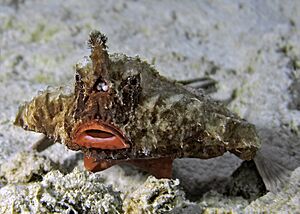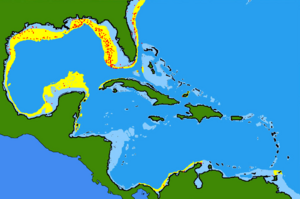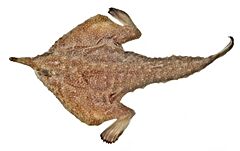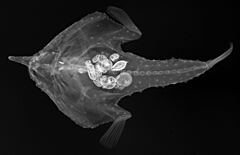Longnose batfish facts for kids
Quick facts for kids Longnose batfish |
|
|---|---|
 |
|
| Specimen at Bari Reef, Bonaire | |
| Conservation status | |
| Scientific classification | |
 |
The longnose batfish (scientific name: Ogcocephalus corniger) is a unique type of ray-finned fish. It belongs to a group called Ogcocephalidae, which are often known as deep-sea batfishes.
You can find this fish in the Atlantic Ocean, living deep underwater. It usually swims at depths between 29 and 230 meters (about 95 to 755 feet). Its home stretches from North Carolina down to the Gulf of Mexico and the Bahamas.
Like other batfishes, it has a flat, triangle-shaped body. Its colors can range from yellowish to purple. It often has light, round spots. A cool fact is its lips are bright orange-red! It also has a special part on its head, just like other anglerfish.
Contents
About the Longnose Batfish Name
The longnose batfish was officially named Ogcocephalus corniger in 1980. An American fish expert, Margaret G. Bradbury, described it for the first time. She found it off the coast of Florida.
The name Ogcocephalus comes from two old Greek words. Ogkos means "hook," and cephalus means "head." This name refers to the pointed snout on some batfish species.
The second part of its name, corniger, is also from Latin. Cornus means "horn," and niger means "to bear" or "to carry." This describes the long, upward-pointing snout that looks a bit like a horn on this fish.
What Does the Longnose Batfish Look Like?
The longnose batfish has a very flat head. This head is a bit taller than the rest of its body, which is shaped like a triangle. It has a long, pointed snout that sticks out far past its eyes. Its eyes are on the sides of its head.
This fish has a special lure, called an esca. It has three fleshy points and can be pulled back into a hidden space under its snout. This lure helps it attract prey.
Its body is covered in large, shield-like scales. These scales have pointy spines. The underside of its body is also covered in bony, pointed scales. The underside of its tail has many small spines.
The top of its body is usually chocolate brown or dark reddish-brown. It has many small, pearly gray spots. These spots are actually the uncolored tips of its scales. Its lips are a bright red color, and its lower body has an orange-red tint.
Its fins also have interesting colors. The pectoral fins (the ones on its sides) can be orange, yellow, or purplish. They have dark edges and white tips. The pelvic fins (underneath) are often orange-red with dark tips. The anal fin (under the tail) is dark or black at the end. The dorsal fin (on its back) is dusky and might have light stripes. Its caudal fin (tail fin) is brown at the base, orange in the middle, and has a black edge.
The longnose batfish can grow up to 23 centimeters (about 9 inches) long.
Where Does the Longnose Batfish Live?
The longnose batfish lives in the western part of the Atlantic Ocean. You can find it along the eastern coast of the United States, from North Carolina down to the Bahamas. It also lives in the Gulf of Mexico. Here, it's found from the Florida Keys all the way to Mexico, near places like Tampico and Yucatán.
In the Caribbean Sea, this fish is seen from Mexico to Belize. It's also found from Colón in Panama to the Guajira Peninsula in Colombia. Sometimes, a few brave batfish travel as far north as New York!
This species prefers to live on sandy parts of the ocean floor. It likes depths between 29 and 230 meters (about 95 to 755 feet).
Life and Habits of the Longnose Batfish
The longnose batfish is a bottom-dwelling fish. We don't know a lot about its daily life, but we do know how batfishes generally behave.
Batfishes are ambush predators. This means they wait quietly for their food to come to them. They mostly eat small snails, clams, crabs, worms, and sometimes tiny fish.
The longnose batfish stays very still on the seafloor. It moves its special lure (the rostrum) back and forth. This movement tricks small animals into thinking it's something tasty. When prey gets close, the batfish quickly opens its mouth and sucks the food in!
This fish is not a good swimmer. When it needs to move, it "walks" along the bottom using its strong, limb-like fins. It can also jump or crawl. If it feels threatened, it can quickly bury itself in the sand to hide.
In aquariums, some longnose batfish have lived for up to 8 years.




